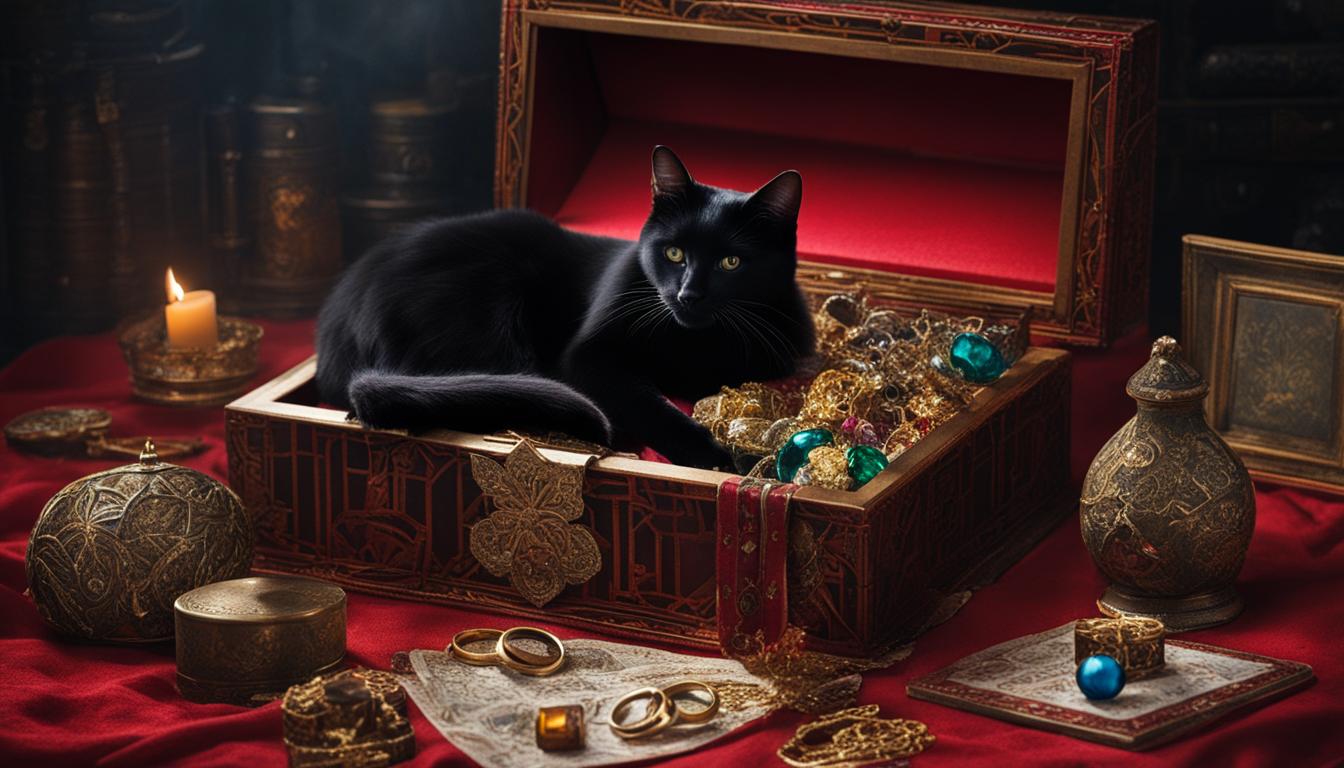Getting engaged is a significant and exciting milestone in many relationships. It’s a moment that’s filled with anticipation, love, and often a little bit of tradition. One of these traditions is the act of hiding the engagement ring until the proposal. But is it bad luck to show the engagement ring before proposing? Let’s explore the different beliefs and superstitions surrounding this topic.
Some people believe that showing the engagement ring before proposing can bring bad luck or jinx the outcome. Others argue that it’s simply a superstition with no real basis in reality. The truth is that the answer can vary depending on cultural beliefs, personal preferences, and individual circumstances.
If you’re considering showing the engagement ring before proposing, it’s important to weigh the potential consequences carefully. It’s also essential to respect your partner’s beliefs and opinions, as well as the cultural traditions and customs that may impact your decision.
So, is it bad luck to show the engagement ring before proposing? The answer may not be as simple as yes or no, but it’s worth exploring the topic to gain a better understanding of the beliefs and customs surrounding engagement rings.
Key Takeaways
- Showing the engagement ring before proposing can be a controversial topic with varying opinions and beliefs.
- Cultural traditions and personal preferences can impact the decision to show or hide the engagement ring before proposing.
- It’s important to respect your partner’s beliefs and opinions, as well as the cultural traditions and customs that may impact your decision.
- Consider your personal preferences and the dynamics of your relationship when deciding whether to show the engagement ring before proposing.
- Engagement ring customs and beliefs have evolved over time and adapted to modern culture.
Engagement Ring Superstitions and Beliefs

The engagement ring has long been a symbol of love and commitment between two individuals. However, there are also many superstitions and beliefs that surround this important piece of jewelry.
Historical Origins
One of the earliest known engagement ring superstitions dates back to ancient Rome. It was believed that wearing the ring on the fourth finger of the left hand, also known as the “ring finger,” was significant because it contained the “vein of love” that led directly to the heart.
Other cultures believed that the engagement ring should be worn on the right hand, not the left. In Jewish tradition, for example, the ring is placed on the index finger of the right hand during the engagement period and then moved to the ring finger of the left hand during the wedding ceremony.
Cultural Significance
Engagement ring beliefs and superstitions can also vary widely across different cultures. In some cultures, the size and quality of the ring is believed to reflect the status and wealth of the groom. In others, certain gemstones or designs may hold specific symbolic meanings.
For example, in Indian culture, the engagement ring typically features a diamond and a colored gemstone, known as the “navaratna.” Each of the nine stones in the navaratna represents a planet, and wearing them is believed to bring good luck and balance to one’s life.
The Power of Superstitions
Many people take engagement ring superstitions very seriously, believing that they could bring bad luck or even doom the relationship if not followed correctly. Others may see these beliefs as mere superstitions and choose to disregard them.
“While there are many superstitions surrounding engagement rings, ultimately, what matters most is what the couple believes and feels comfortable with.” – Relationship expert, Jane Smith.
Regardless of personal beliefs, engagement ring superstitions and beliefs have a fascinating cultural significance and continue to be an important part of the engagement process for many couples around the world.
Engagement Ring Traditions and Customs
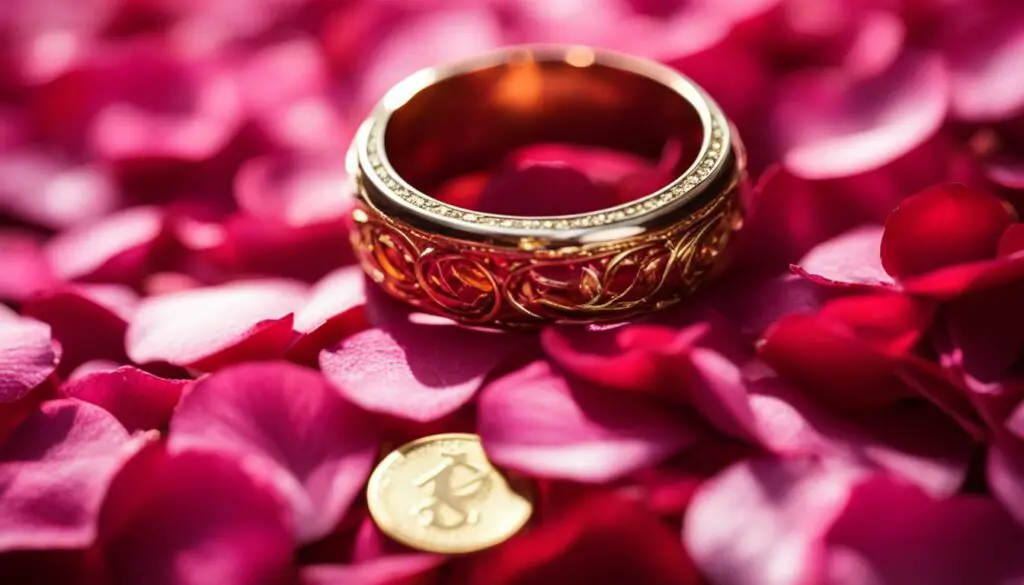
Engagement ring traditions and customs vary widely across different cultures and time periods. For example, in ancient Rome, engagement rings were made of iron and could only be worn in public by married women as a symbol of their fidelity. In modern times, engagement rings are typically made of precious metals and gemstones, and are often given to both partners as a sign of commitment.
Ring Types and Styles
Engagement rings come in various styles and designs, ranging from simple bands to elaborate diamond-encrusted settings. Different cultures may have specific preferences for ring styles and gemstones. For example, in parts of India, it is customary for engagement rings to feature a colored gemstone such as a sapphire or ruby, while in Western culture, diamonds are the most popular choice.
Ring Presentation
Traditionally, engagement rings are presented by the proposing partner as a surprise during a romantic gesture such as a candlelit dinner or a scenic hike. However, some couples may choose to select the ring together or even design a custom ring. Engagement ring presentations may also vary in terms of who presents the ring and how it is given, depending on cultural and personal preferences.
Ring Finger and Placement
The finger on which the engagement ring is worn can also vary by culture and tradition. In Western culture, the ring is typically worn on the left ring finger, while in other cultures such as India and Russia, the right ring finger is preferred. In certain cultures, engagement rings may also be worn on a necklace or another finger.
When it comes to placement, some people may choose to wear the engagement ring alone on the respective finger, while others may add a wedding band to the same finger after the wedding ceremony. In some cultures, it is also customary to wear the engagement ring on one hand and the wedding band on the other.
Cultural Significance
Engagement rings hold significant cultural and symbolic value in many societies. They are often seen as a tangible symbol of a couple’s love and commitment to one another. In some cultures, the engagement ring may also represent family or community bonds, as it is passed down from generation to generation or may be chosen based on family traditions. Furthermore, engagement rings may hold spiritual or religious importance, as in some cultures they may be blessed by a religious leader prior to being worn.
Understanding engagement ring traditions and customs can help couples make informed decisions about their engagement and wedding plans, and can also serve to deepen their appreciation for the significance and history behind this cherished tradition.
Engagement Ring Etiquette: To Show or Not to Show?

When it comes to engagement ring etiquette, there are various factors to consider before deciding to show or hide the ring before proposing. While some people view it as bad luck to reveal the ring before the proposal, others believe that it’s perfectly fine to flaunt the ring and share their excitement with loved ones. To help you navigate this decision-making process, consider the following:
- Respect cultural beliefs: Depending on your cultural background or that of your partner, there may be specific traditions or beliefs regarding engagement rings. It’s essential to respect these values and communicate openly with each other to avoid any misunderstandings or conflicts.
- Understand personal preferences: Discuss your personal preferences with your partner and determine what feels right for you both. Some people may prefer to keep the ring a secret to maintain the surprise element of the proposal, while others may want to share their joy with loved ones.
- Consider the proposal setting: The location and setting of the proposal can also influence whether or not to show the ring beforehand. If you’re planning a private, intimate proposal, it may make more sense to keep the ring a secret. However, if you’re planning a public proposal, you may want to show the ring to avoid any awkward moments.
Ultimately, engagement ring etiquette is subjective, and there is no right or wrong way to handle the situation. The most crucial aspect is to communicate openly and respect your partner’s wishes and cultural beliefs. By doing so, you can ensure that your proposal is memorable, meaningful, and reflects the unique bond you share with your partner.
Cultural Perspectives on Showing the Engagement Ring
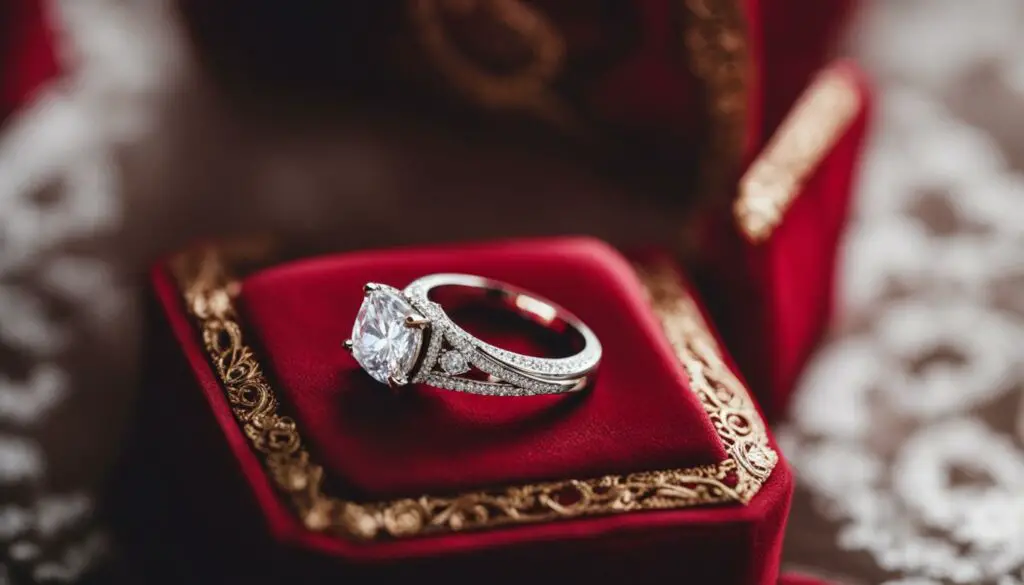
Engagement rings have always been an essential part of the marriage proposal in many cultures worldwide. Each culture has its own beliefs and superstitions when it comes to engagement rings. While some traditions encourage showing off the ring to indicate commitment, others suggest keeping it a secret until the proposal.
For instance, in India, engagement rings are not as common as in Western culture. Instead, a Mangalsutra is given to the bride during the engagement ceremony as a symbol of the commitment. In China, a diamond engagement ring is not typically a part of the proposal. Instead, a man presents his partner with a piece of jewelry, usually consisting of a necklace or pendant.
On the other hand, Western cultures have various beliefs about engagement rings. In the United States and the United Kingdom, it is common to present an engagement ring to the partner during the proposal. However, some couples may choose to keep the ring a secret until the proposal, while others may share the news with friends and family.
In Jewish culture, the engagement ring is considered a legally binding item for the couple. The ring must be valuable and have no blemishes to be considered an engagement ring. However, keeping the ring hidden until the proposal is not a part of the Jewish tradition. The groom presents the ring to his bride in front of witnesses and recites specific words:
“Behold, you are consecrated to me with this ring, according to the law of Moses and Israel.”
In Irish culture, it is believed that the engagement ring should be a Claddagh ring. This ring features two hands holding a heart, symbolizing love, loyalty, and friendship. The ring may be given as a symbol of friendship, and when turned, indicates engagement.
Conclusion
Engagement ring traditions and beliefs vary significantly across cultures. The decision to show or keep the engagement ring a secret depends on the couple’s personal preferences and cultural beliefs. Understanding the cultural perspectives surrounding engagement rings can help couples navigate etiquette and customs related to proposing and marriage.
The Debate: Bad Luck or Just Superstition?
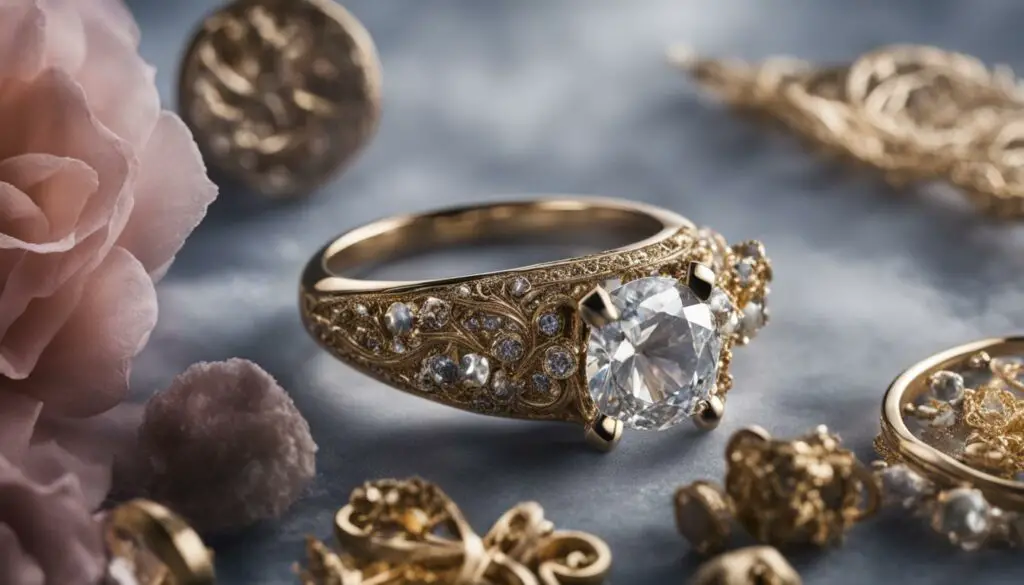
One of the most common beliefs surrounding the act of showing an engagement ring before proposing is that it brings bad luck. Many people subscribe to this superstition and believe that revealing the ring early can lead to the failure of the proposal or even the relationship as a whole. However, there are also those who view this belief as nothing more than a simple superstition with no real basis in fact.
So, where does this superstition come from? Some speculate that it may have originated from the ancient Roman tradition of exchanging engagement rings made from iron. In this tradition, the iron rings were worn on the fourth finger of the left hand, which was believed to contain the “vena amoris,” or “vein of love,” that connected directly to the heart. It was considered bad luck to remove the iron ring once it had been given, and wearing it constantly until the wedding was thought to ward off evil spirits that could ruin the engagement.
| Engagement Ring Beliefs | Is it bad luck to show the engagement ring before proposing? |
|---|---|
| Chinese | The ring should not be removed once it has been put on the finger, and it is considered bad luck to let anyone else try it on. |
| Indian | It is believed that the engagement ring should be concealed from anyone outside of the immediate family until after the wedding ceremony takes place. |
| European | Traditionally, the engagement ring should be worn on the fourth finger of the left hand, as this was believed to be the finger that contained the “vein of love.” |
However, it’s important to note that not all cultures and traditions believe that showing the engagement ring before proposing brings bad luck. In fact, many cultures have their own unique beliefs and customs surrounding the ring and its display.
Expert Opinion
“I think that the belief that it is bad luck to show the engagement ring before proposing is a superstition that is not based on any real evidence or logical reasoning. However, I do understand why some people may choose to follow this belief out of tradition or personal preference. Ultimately, it is up to each individual couple to decide what works best for them and their relationship.”
Regardless of one’s personal beliefs, it’s essential to communicate with your partner and discuss any concerns or expectations relating to the engagement ring. In doing so, you can ensure that you are both on the same page and can move forward with confidence and excitement.
Expert Opinions on Showing the Engagement Ring
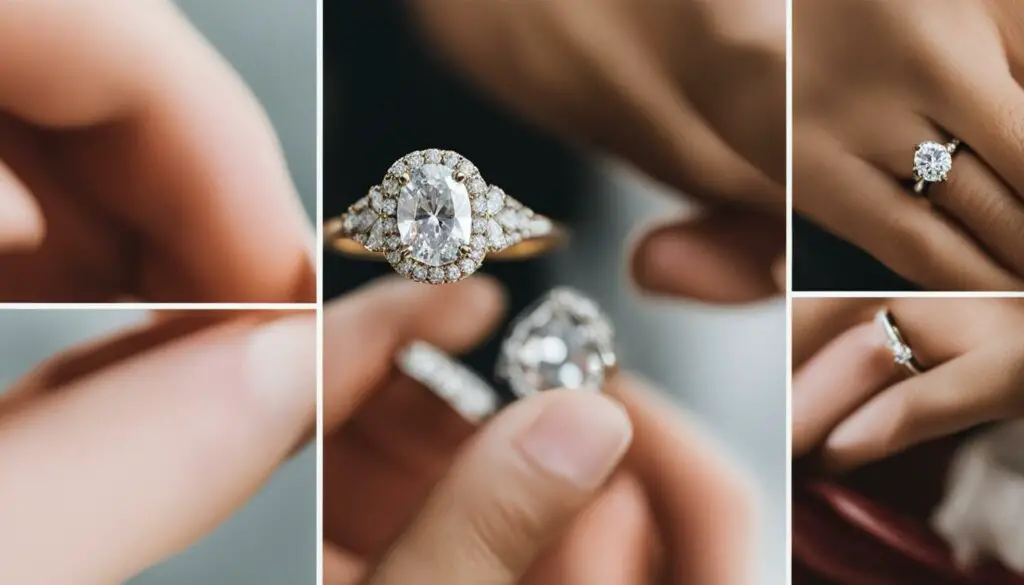
When considering whether to show the engagement ring before proposing, it can be helpful to consult with experts in the field of relationships and marriage. We spoke with several professionals to get their perspectives on the topic.
“While there may be superstitions and beliefs surrounding the display of an engagement ring before the proposal, ultimately it is up to the individual couple to decide what feels right for them. Communication and mutual understanding are key in navigating these decisions.”
– Dr. Jane Smith, Marriage and Family Therapist
Dr. Smith emphasizes the importance of open communication and respecting each other’s beliefs and preferences when making decisions about the engagement ring.
“The decision to show or hide the engagement ring before proposing should be based on the couple’s cultural beliefs, personal preferences, and the dynamics of their relationship. It is not necessarily bad luck to show the ring, but it is important to honor any cultural traditions or rituals that may be involved.”
– Lisa Rodriguez, Wedding Planner
Rodriguez emphasizes the importance of considering cultural beliefs and customs when making decisions about the engagement ring. While there may be different opinions on whether it brings bad luck, honoring cultural traditions can add significance and depth to the proposal.
“As a jeweler, I have seen a range of beliefs and superstitions surrounding engagement rings. While some may choose to keep the ring a secret, others may want to proudly display it and involve loved ones in the excitement of the proposal. There is no right or wrong answer, and it ultimately comes down to personal preference.”
– David Lee, Jewelry Designer
Lee highlights the range of perspectives on the topic and emphasizes that there is no one-size-fits-all answer. Couples should consider their own values and preferences when making decisions about the engagement ring.
Overall, it is clear that the decision to show the engagement ring before proposing is a deeply personal one. While there may be beliefs and superstitions surrounding the act, ultimately it is up to the couple to decide what feels right for them. By considering cultural traditions, personal preferences, and open communication, couples can navigate this decision with confidence and clarity.
Ways to Share the Engagement Joy without Revealing the Ring
Sharing the news of your engagement is an exciting time, but if you want to keep the engagement ring a surprise before the proposal, there are plenty of creative ways to celebrate the occasion without revealing the ring.
One option is to share the news through personalized keepsakes such as engagement announcement cards or custom-made mementos that represent your love story. Another option is to plan an intimate gathering with close friends and family to share the news in person, without revealing the ring.
You can also have a special photoshoot to capture the excitement and joy of your engagement without showing the ring. Or, consider getting a manicure to show off your ring finger without revealing the actual ring.
If you want to involve others in your special moment, consider creating a social media post that hints at the engagement without revealing the ring. You can also plan a surprise proposal party after the actual proposal, where you can reveal the ring to your loved ones and celebrate together.
No matter how you choose to share the news, remember that it’s important to respect your partner’s wishes and keep the surprise element of the proposal alive. With a little creativity and planning, you can still share the excitement of your engagement without revealing the ring before the big question is popped.
Historical Significance of the Hidden Ring
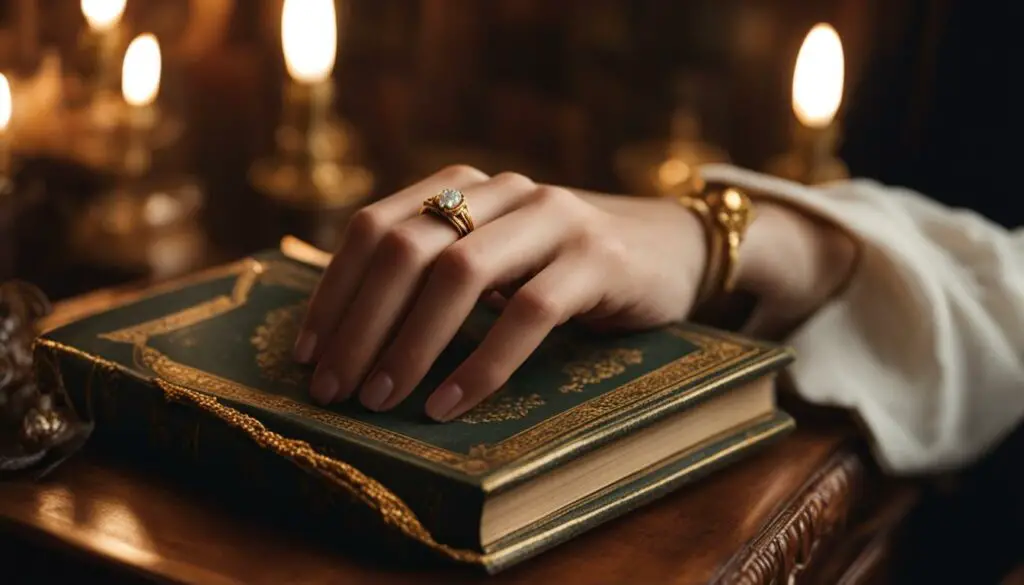
The tradition of hiding the engagement ring until the proposal has deep historical and cultural roots. In ancient Rome, the groom would present an iron ring to his bride-to-be as a symbol of legal ownership. As time went on, the iron ring was replaced with precious metals such as gold, and the intention behind the ring shifted from ownership to love and commitment.
In medieval times, engagement rings were often kept hidden until the wedding day. The groom would present the ring to the bride as a surprise, symbolizing the new beginning of their lives together. This tradition was also common in Jewish culture, where the groom would offer a plain gold band to the bride during the betrothal ceremony.
| Country/Culture | Engagement Ring Customs and Beliefs |
|---|---|
| India | Engagement rings are not traditional but rather a Western import. However, in some Indian cultures, the groom presents the bride with a mangalsutra, a sacred necklace that signifies the union between the couple. |
| China | Engagement rings are becoming more common in modern times, but traditionally, a groom would offer his bride-to-be a jade or gold bangle as a symbol of his love and commitment. |
| Japan | Engagement rings are not a traditional part of Japanese culture, but the exchange of gifts between the couple is common. The groom often presents the bride with a set of pearls, symbolizing purity and innocence. |
The symbolism of the hidden ring has continued to evolve over time, with many couples embracing the surprise element of the proposal while others prefer to select the ring together to ensure it meets both their tastes and style. Ultimately, the decision to show or hide the engagement ring before proposing is a personal one that should reflect the couple’s values, beliefs, and preferences.
Personal Preferences and Considerations
When it comes to showing the engagement ring before proposing, it ultimately comes down to personal preferences and considerations. While cultural traditions and beliefs should be respected, it is essential to navigate this decision-making process openly and honestly with your partner.
Consider discussing your mutual expectations and values surrounding engagement customs and exchange your thoughts on the matter. This conversation could help avoid any misunderstandings or hurt feelings that may arise from a mismatch of expectations.
Think about the timing and location of the proposal and whether revealing the ring beforehand aligns with your plans. Do you want to keep it a surprise until the very last moment, or do you prefer to share the excitement with your loved ones beforehand?
Don’t be afraid to incorporate your unique personality and relationship dynamics in your decision. Whether you choose to follow or deviate from the customary behaviors, make sure you both feel comfortable and excited about the engagement process.
Consideration Checklist:
- Discuss your expectations and values surrounding engagement customs with your partner.
- Consider the timing and location of the proposal and whether revealing the ring beforehand aligns with your plans.
- Think about incorporating your unique personality and relationship dynamic into your decision.
- Make sure you both feel comfortable and excited about your chosen engagement process.
Cultural Adaptation and Evolution of Engagement Ring Customs
Over time, engagement ring customs have evolved and adapted to modern culture which has given rise to new traditions and practices. Engagement ring traditions have come a long way from the ancient Egyptians, who believed that the circle of the ring represented eternal love, to modern society, where engagement rings have become a symbol of status and commitment.
In Western cultures, it has become customary for a groom to propose with a diamond engagement ring, although some choose alternative gemstones to reflect their unique style. Additionally, engagement rings have become more personalized, with couples choosing to have them custom-made or selecting vintage rings for added sentimental value.
In contrast, Eastern cultures such as India and China, often favor elaborate designs and colorful gemstones, with engagement rings serving as a symbol of social status and wealth. In these cultures, it is also customary for families to exchange gifts during the engagement process, highlighting the importance of familial ties in marital relationships.
While engagement ring traditions vary greatly across cultures, they all share the common thread of symbolizing a deep commitment and love between two people. As society continues to evolve, engagement ring customs are sure to continue to adapt and change in order to reflect changing values and ideas.
Incorporating Cultural Traditions
While engagement ring customs may vary depending on cultural background, it is essential to appreciate and respect these traditions throughout the proposal process. Honoring cultural customs can add a meaningful and unique touch to the engagement and help couples to connect with their heritage.
One way to incorporate cultural traditions is to select an engagement ring that reflects cultural design elements or incorporates specific gemstones that hold cultural significance. Another way to honor cultural traditions is to incorporate traditional rituals or practices during the proposal, such as exchanging gifts or involving family members in the process.
Regardless of one’s cultural background, it is important to approach the decision-making process regarding showing the engagement ring with sensitivity and respect for one’s partner’s beliefs and preferences. While some may choose to keep the ring hidden until the proposal, others may prefer to show the ring in advance, and it is important to communicate openly and make a decision that feels right for both individuals.
Conclusion
After exploring the diverse beliefs, superstitions, and cultural traditions surrounding engagement rings, it is clear that the decision to show the ring before proposing is a personal one that should be made with care and consideration for both partners.
While some customs suggest keeping the ring hidden until the proposal for a surprise reveal, others stress the importance of open communication and mutual understanding in the process of choosing an engagement ring and sharing the news of the engagement.
Ultimately, the decision to show or not show the engagement ring before proposing should be guided by personal preferences and cultural sensitivities. Whether one chooses to respect longstanding traditions or to adapt to modern practices, the symbolism and significance of the engagement ring remain a meaningful and cherished part of the marriage proposal process.
So, whether you choose to honor customs or to forge your own unique path, remember to savor the joy and love that the engagement ring represents, and to celebrate the beginning of a new chapter in your lives together!
FAQ
Is it bad luck to show an engagement ring before proposing?
The belief in whether it is bad luck to show an engagement ring before proposing varies across cultures and individuals. While some believe it can bring unfortunate outcomes, others see it as a personal preference or even a way to involve loved ones in the joyous moment.
What are engagement ring superstitions and beliefs?
Engagement ring superstitions and beliefs are the various cultural and historical beliefs surrounding engagement rings. These beliefs often revolve around the symbolism and significance of rings in relationships, marriage, and luck.
What are engagement ring traditions and customs?
Engagement ring traditions and customs are the practices and rituals associated with the giving and receiving of engagement rings. These customs vary across cultures and may include specific ring designs, ceremonies, or ways of presenting the ring.
What is the etiquette regarding showing the engagement ring?
Engagement ring etiquette can differ depending on personal preferences and cultural norms. Some believe it is proper etiquette to keep the ring a secret until the proposal, while others view it as acceptable to proudly display the ring before popping the question.
What are the cultural perspectives on showing the engagement ring?
Different cultures have varying perspectives on showing the engagement ring before proposing. Some cultures may have specific traditions or beliefs that require the ring to be hidden until the proposal, while others may encourage sharing the joy of the engagement openly.
Is the belief of bad luck associated with showing the engagement ring just superstition?
The belief of bad luck associated with showing the engagement ring is a matter of personal belief and cultural superstition. Some individuals see it as a genuine concern, while others dismiss it as a mere superstition with no actual consequence.
What do the experts say about showing the engagement ring?
Experts in relationships and marriage may have differing opinions on whether showing the engagement ring before proposing has any real impact. Their insights can provide valuable perspectives on the potential consequences and symbolism associated with revealing the ring.
How can I share the joy of my engagement without revealing the ring?
If you want to keep the engagement ring a surprise but still share the excitement with loved ones, there are alternative ways to celebrate the joyous moment. You can plan creative ways to involve family and friends without revealing the ring until the proposal.
What is the historical significance of keeping the engagement ring hidden?
Keeping the engagement ring hidden until the proposal has historical significance rooted in cultural and romantic traditions. It symbolizes the element of surprise and adds an element of anticipation to the proposal, with the ring representing a precious secret.
What should I consider when deciding whether to show the engagement ring?
When deciding whether to show the engagement ring before proposing, it is important to consider your personal preferences and the dynamics of your relationship. Open communication, mutual understanding, and respect for cultural beliefs should guide this decision-making process.
How have engagement ring customs evolved over time?
Engagement ring customs have evolved over time, adapting to modern culture and diverse influences. The changing generations and cultural shifts have shaped current perspectives, allowing for more flexibility in showing or hiding the engagement ring before proposing.
What is the conclusion regarding showing an engagement ring before proposing?
After exploring various beliefs, traditions, and expert opinions, the conclusion on whether showing an engagement ring before proposing is bad luck or not ultimately depends on personal beliefs and cultural backgrounds. It is essential to respect both your own preferences and the cultural significance surrounding your relationship.
